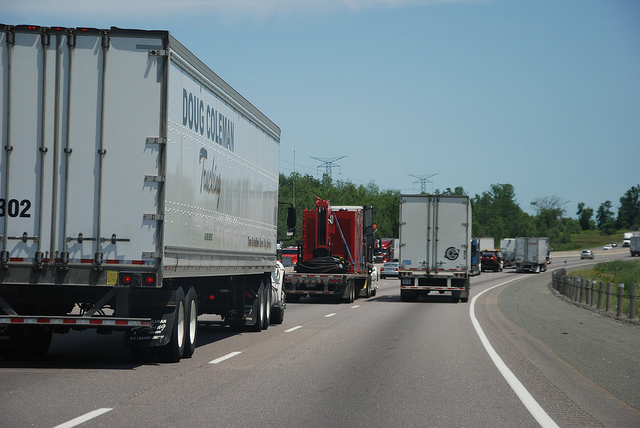We’ve all been there — either as a driver or passenger — sandwiched between, in front of and behind 18-wheelers on the highway. Trucks seem to be everywhere: highways, urban avenues and even on residential streets. Trucks (as well as ships, trains and airplanes) move the goods and services we have in our homes and offices — from delivering our mail and our groceries to having a plumber come to fix our kitchen sink. We often don’t think of the impact that freight has on our everyday lives, but it is the backbone of the provincial economy. The Ministry of Transportation’s Freight-Supportive Guidelines notes that trade between Ontario and the United States amounted to over $284 billion in 2011 and almost 40 per cent of Ontario’s economy is generated by freight-intensive industries.
All of that economic activity comes with an equally large environmental footprint. As a whole, the transportation sector is the largest source of emissions in Ontario, and freight represents 10 per cent of the province’s emissions. It has been the fastest growing sub-sector of transportation since 2000, and is projected to become the largest energy-consuming segment of transportation globally by 2030. This is due to a number of factors including growing populations and businesses, manufacturing goods from international markets, the increasing popularity of online shopping and the expectation of receiving goods quickly. To date, efforts to curb these emissions have not been a high priority for governments and civil society, but there is a great opportunity to find solutions to cut freight emissions, and help Ontario achieve its emissions targets.
Challenges facing freight
As Ontario’s urban populations continue to grow, so does the number of commercial, manufacturing, office and industrial businesses coming to our neighbourhoods. We will increasingly feel the pressure on our transportation networks as we are vying for the same space to move us, as well as goods and services. The result is traffic congestion, noise on our streets and increased air pollution and greenhouse gas emissions.
There are other challenges that the freight industry is facing. Rising urban land costs means that more and more warehousing and distribution centres tend to be in the suburbs, increasing travel times as well as kilometres travelled. Many urban deliveries are also stuck in traffic congestion, which decreases fuel efficiency and leads to drivers circling around city streets to find parking or parking illegally due to limited loading areas. All of these challenges leads to increasing prices for the trucking industry and us, in turn, as well as increased emissions from their operations.
Looking at solutions
 In our Greening the Goods report, we identified some of these challenges, but also suggested a number of recommendations for addressing challenges of goods movement within cities. These included looking at off-peak deliveries, enhancing truck parking, sharing data amongst industry players and incentive programs for low-emission vehicles. There are already examples we can look at, like the pilot project of off-peak deliveries during the 2015 Pan-Am Games, led by the Ministry of Transportation. We also recommended that the City of Toronto, neighbourhood Business Improvement Areas, the Province of Ontario and the freight industry work to make Toronto a “smart freight city,” where goods are moved more efficiently and with less pollution. An element of this smart freight city includes establishing neighbourhood freight forums — which the Pembina Institute will be doing in the coming months.
In our Greening the Goods report, we identified some of these challenges, but also suggested a number of recommendations for addressing challenges of goods movement within cities. These included looking at off-peak deliveries, enhancing truck parking, sharing data amongst industry players and incentive programs for low-emission vehicles. There are already examples we can look at, like the pilot project of off-peak deliveries during the 2015 Pan-Am Games, led by the Ministry of Transportation. We also recommended that the City of Toronto, neighbourhood Business Improvement Areas, the Province of Ontario and the freight industry work to make Toronto a “smart freight city,” where goods are moved more efficiently and with less pollution. An element of this smart freight city includes establishing neighbourhood freight forums — which the Pembina Institute will be doing in the coming months.
Additionally, as part of Metrolinx’s Big Move – the Greater Toronto and Hamilton’s multi-modal 25-year regional transportation plan, they have been tasked with developing a comprehensive freight strategy. As it currently stands, there is not a large focus on freight, and we look forward to contributing our thoughts as they undertake their 10-year review. We will be looking at progress to date and making additional recommendations on what the region can do to improve freight movement and reduce greenhouse gas emissions.







